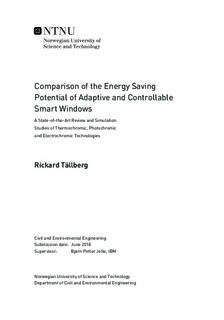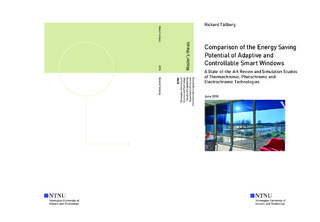| dc.description.abstract | Today s building sector in the EU stands for about 40 % of the total energy consumption and about 75 % of all buildings are energy inefficient. By making both the new and the existing buildings smarter and more energy efficient, the goal is to cut CO2 emissions by at least 40 % by 2030 and to reach a low and zero-emission building stock in the EU by 2050. This was stated in a press release made by the European Commission the 17th of April 2018.
While windows play a huge role in today s buildings, allowing for outside view and providing occupants with daylight, it is also often considered to be one of the weakest building component with high thermal losses and is often the reason for overheating and glare issues. In comparison to traditional static windows, dynamic solutions like adaptive and controllable smart windows have the ability to adjust their optical properties in response to changing boundary conditions and hence have the potential to improve the energy performance and the user comfort of buildings.
The objective of this work is twofold: (1) To collect and present the state-of-the-art commercially available smart windows from manufacturers, both adaptive and controllable products, i.e. thermochromic, photochromic and electrochromic smart windows. This collection provides the reader with valuable information about window properties such as the U-value, g-value, solar transmittance (Tsol) and visible solar transmittance (Tvis). However, it is currently difficult to obtain all the desired information about the products from the manufacturers websites and other open channels. (2) To conduct building energy performance simulations on selected products from each technology. These products are also simulated using the same U-values as the reference window, and in addition, two theoretical cases have been simulated to investigate the theoretical potential of different smart windows. Here, the optical parameters take on fictious values between 10 to 90 % and between 0 to 100 % transmittance, respectively. All cases are simulated at three different locations, i.e. Trondheim (Norway), Madrid (Spain) and Nairobi (Kenya), and are compared to a reference static window. In total, 63 cases are simulated using the simulation software package IDA Indoor Climate and Energy (IDA ICE). The results shows that the electrochromic window controlled by operative temperature has the highest potential in lowering the energy demand for all cases and locations. The study also highlights the importance of having the right control strategy and control levels for each specific case. | |

